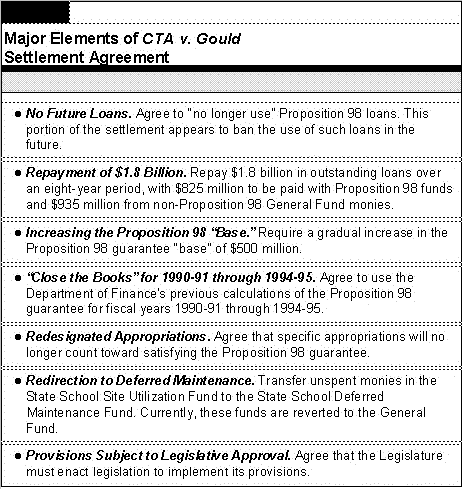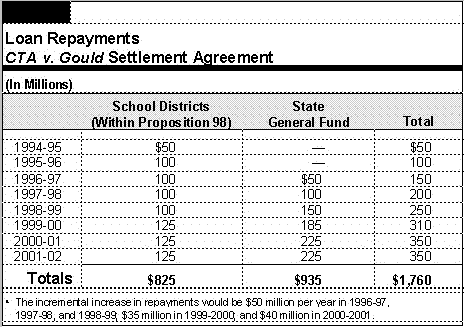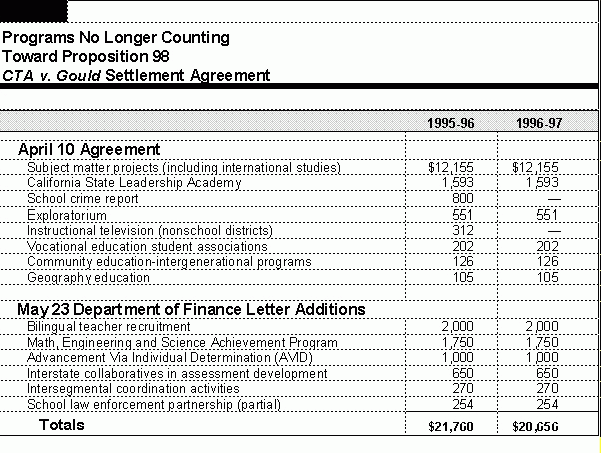
June 6, 1996
 |
Proposed Settlement Agreement of CTA v. Gould |
Proposition 98 (as amended by Proposition 111) establishes a minimum state funding level for K-14 education. As a major part of its response to budget crises during 1991-92 through 1993-94, the state allowed schools to spend above the minimum Proposition 98 guarantee through the use of Proposition 98 "loans" that would be repaid in future years. The California Teachers Association (CTA) challenged the constitutionality of these loans in CTA et al. v. Gould. On April 10, 1996, the Director of Finance, the CTA, and the other parties to the case reached a formal settlement agreement.
The major provisions of the agreement are:
The settlement agreement will not take effect unless the Legislature enacts legislation approving its provisions. In considering the proposed agreement's costs, the Legislature must weigh these certain costs against the potential fiscal implications of a court judgment against the state. For instance, the state could have been directed to repay the $1.8 billion in loans with General Fund monies and immediately restore $600 million to the permanent Proposition 98 base.
In our view, the proposed settlement's terms appear to be a reasonable compromise of the issues. Almost half of the loan payments would be paid within the current Proposition 98 funds. In addition, the agreement cushions both Proposition 98 and the General Fund from large payments in any one year by spreading payments over a multiyear period. Permanent increases to Proposition 98 funding levels are also crafted to minimize the impact on the General Fund. Consequently, we recommend that the Legislature approve the terms of the agreement.
Proposition 98 (as amended by Proposition 111) establishes a minimum state funding level for public schools and community colleges (K-14 education). This minimum level is determined each fiscal year on the basis of one of four specified formulas.
As a major part of its response to budget crises during fiscal years 1991-92 through 1993-94, the state allowed schools to spend above the minimum Proposition 98 guarantee through the use of Proposition 98 "loans." These loans totaled $3.1 billion. Of this amount, $1.3 billion was in loans made to avoid overappropriation of the Proposition 98 guarantee, and $1.8 billion was in "advances" against future Proposition 98 spending.
The purpose of these loans was to maintain K-12 per-pupil spending at the level provided in the 1991 Budget Act without exceeding the minimum level of state funding required by Proposition 98. The Legislature and the Governor did not want to exceed the Proposition 98 minimum because spending above the minimum level in any given year increases the "base" funding required in future years.
The California Teachers Association (CTA) challenged the constitutionality of these loans in CTA et al. v. Gould. At stake in the lawsuit was $1.8 billion in Proposition 98 advances and over a billion dollars in permanent funding CTA wanted restored to the Proposition 98 guarantee.
In April 1994, the Superior Court in Sacramento County ruled the loans unconstitutional. Thus, the schools would not have to make the $1.8 billion in loan repayments. The court did not, however, require full adjustment of the permanent Proposition 98 guarantee level but in effect the ruling would restore approximately $600 million in permanent funding. Both CTA and the state promptly appealed this ruling. While the appeal was pending, the parties to the lawsuit reached a tentative settlement in July 1995.

On April 10, 1996, the parties reached a formal settlement agreement that mirrors last summer's tentative settlement agreement in most major respects. (See Figure 1.) The agreement will not take effect until the Legislature enacts legislation implementing its various provisions. In addition, all parties to the lawsuit must agree in writing that the enacted legislation satisfies the agreement's terms. Once this is done, the agreement would be forwarded to the State Court of Appeal (ThirdDistrict) with a request to substitute the settlement agreement as an order of the court in place of the lower court judgment. Those signing the proposed settlement agreement include the Director of Finance, the Superintendent of Public Instruction, the State Controller, and representatives of the CTA and the California Schools Boards Association.
The following items of the formal agreement are consistent with the tentative settlement.
Prohibits Future Loans. As part of the agreement, the state promises to "no longer use" the Proposition 98 loan mechanism. This is an important element to the agreement because it appears to bar the use of loans in any future state fiscal crisis. While such loans are not a desirable way to pay for K-14 programs, it should be recognized that the loans did permit the state to maintain a higher level of school spending than what otherwise would have been permitted under the minimum funding guarantee.
Repayment of $1.8 Billion. The agreement calls for repaying $1.8 billion in outstanding Proposition 98 loans over an eight-year period. As shown in Figure 2, the repayments would come from two sources:

Increasing the Proposition 98 "Base." The agreement would ultimately increase the Proposition 98 base by $500 million, through two separate actions. First, a total of $225 million would be added permanently to the Proposition 98 guarantee by 2000-2001. This amount corresponds to the level of the state's loan repayment in 2000-2001 and 2001-02 (see Figure 2). Second, the settlement also calls for increasing the Proposition 98 "maintenance factor" by $275 million in 1995-96. This would have the effect, over the long term, of increasing Proposition 98 expenditures by that amount. The $225 million increase in the Proposition 98 base, coupled with the $275 million in additional "maintenance factor," provides $500 million of the disputed Proposition 98 "base".
"Close the Books" for 1990-91 through 1994-95. The parties agree to use the Department of Finance figures for the Proposition 98 guarantee for 1990-91 through 1994-95. Consequently, the settlement avoids any "payback" of disputed funding for these prior years.
There are four new items in the agreement. Two are related to what appropriations count toward satisfying the Proposition 98 guarantee. The third is related to a set-aside for school district maintenance funds and the last deals with payment of costs and fees to the CTA.
Redesignated Appropriations. The agreement prohibits the state from using Proposition 98 funds to support several existing or previously funded education programs. Instead, these programs would be funded with non-Proposition 98 General Fund monies. The April 10 agreement specified eight existing or previously funded education programs. On May 23, the Department of Finance requested the redesignation of these eight programs and the redesignation of six additional program areas. The program redesignations requested in May are consistent with the criteria used in the April agreement. The appropriations for 1995-96 and 1996-97 for these programs are shown in Figure 3 (see next page). This change would not affect General Fund expenditure totals in the current and budget years. The Proposition 98 minimum levels would be adjusted downward to reflect the redesignation. This would free up offsetting amounts of General Fund money to support these programs outside Proposition 98. By placing the redesignated programs outside Proposition 98, however, these programs would have to compete with all other General Fund programs in future years, which may make them more susceptible to future funding reductions.
Statutory Designation of Nonschool Expenditures. The parties agree that Proposition 98 funding provided
to a nonschool agency must be approved by the Legislature through a specific statutory authorization that
is separate from the annual Budget Act. This provision would make it more difficult to use Proposition 98
funds for disputed activities. Even with such statutory authorization, the parties do not waive their rights
to litigate specific disputes in this area.

Redirection to Deferred Maintenance. Also new in this agreement is a proposal to transfer unspent monies
in the State School Site Utilization Fund (SSSUF) to the State School Deferred Maintenance Fund. Under
current law, school districts with unused school sites are assessed a nonuse payment. These payments, which
may come from school district Proposition 98 revenues, are deposited in the SSSUF. Current law also reverts
any balance in the SSSUF annually to the state General Fund. Thus, the proposed change would result in
potential annual losses to the General Fund. (In recent years, the reversions ranged between $3.5 million
and $5.8 million.) Since Proposition 98 funds or other district revenues are the sources of monies paid to
the SSSUF, the proposed redirection of unspent SSSUF monies to K-12 needs seems appropriate.
Payment to CTA. The agreement calls for payment to the CTA of $241,834 in full satisfaction of any costs and fees due the CTA in this matter. The agreement states that this amount is equal to half of the fees incurred by the CTA through August 31, 1995. These funds would have to be appropriated by the Legislature, presumably from non-Proposition 98 General Fund monies.
As part of negotiations on the 1995 Budget Act last summer, the principal parties involved in this litigation agreed to a tentative settlement agreement. As incentive to complete that agreement, the education trailer act, Ch 308/95 (AB 825, W. Brown), set aside $360 million for various school programs, with release of funds contingent on conclusion of a final settlement agreement. The latest revised estimate of the contingent funding is $401 million. The amount has increased due to higher estimates of the cost of revenue limit "deficit reduction" and equalization. Figure 4 shows the affected programs and revised amounts.
Some major issues remain open for possible future litigation, although all parties agree that the outcome of any litigation would not affect Proposition 98 guarantee levels already determined for fiscal years 1990-91 through 1994-95. These issues include:
| Figure 4 |
| Estimate of
| Funding Contingent On CTA v. Gould Agreementa (In Millions) | | ||
| Revenue limit deficit reduction | $193 |
| Revenue limit equalization | 178 |
| California Assessment Program | 15 |
| Healthy Start Program | 10 |
| Volunteer Mentor Program | 5 |
| Total | $401 |
| a Revenue limit estimates are, in part, contingent on average daily attendance (ADA). Because ADA estimates are still being updated for the current year,
we can expect changes in the revenue limit amounts shown in this figure.
|
In settlements of lawsuits such as CTA v. Gould, the outcome represents a compromise of the different
issues at stake. In this case, there are at least three major issues:
If the state had won the appeal, school districts would have had to repay the $1.8 billion in loans from existing Proposition 98 funds. In addition, no permanent adjustment would have been made to K-14 school funding.
If the state had lost the appeal, it would have faced General Fund costs of $1.8 billion in one-time costs to retire the Proposition 98 loans and possibly over a billion dollars in permanent costs to increase the Proposition 98 base. Furthermore, the court could have required immediate restoration of the base adjustment. This would have had severe consequences for the state's ability to finance non-K-14 education General Fund programs.
Compared to this outcome, the proposed agreement contains a number of elements to reduce the severity of the General Fund impact. First, almost 50 percent of the one-time costs to repay the Proposition 98 loans would come from within existing Proposition 98 funds. Thus, the agreement compromises over the issue of the loan repayments, with the General Fund and Proposition 98 funds contributing roughly half of the funds.
Second, both the General Fund and Proposition 98 payments are spread over a multiyear period. This feature cushions the impact of these repayments in any one year.
Third, the proposed agreement would permanently increase K-14 base funding levels by $500 million. However, this base increase would be phased in over a multiyear period.
The proposed agreement must be weighed against the other possible outcomes of the lawsuit. In our view, the proposed settlement provides a reasonable compromise of the issues. Consequently, we recommend the Legislature approve the terms of the agreement.
This report was prepared by Stuart Marshall, with the assistance of Robert Turnage, under the supervision of
Paul Warren.
|
To request publications call (916) 445-2375. This report and others are available on the LAO's World Wide Web page at http://www.lao.ca.gov. The Legislative Analyst's Office is located at 925 L Street, Suite 1000, Sacramento, CA 95814. |